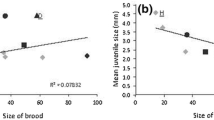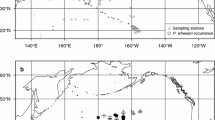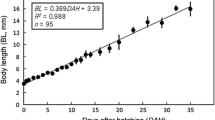Abstract.
In a semiterrestrial and estuarine tropical crab, Armases angustipes Dana (Grapsoidea: Sesarmidae), changes in biomass (measured as dry mass, W; carbon, C; nitrogen, N; and hydrogen, H; per individual) and relative elemental composition (C, N, H, in percent of W; C:N mass ratio) were studied during development from an early egg stage through hatching, the complete larval phase, metamorphosis and the first juvenile crab stage (CI). In the megalopa and CI, growth was measured also within the moulting cycle, and biomass and elemental composition were determined in cast exuviae. From an early egg stage to the freshly hatched larva, A. angustipes lost about 20% of W, 29% of C, 5% of N and 32% of H. Proportionally higher losses in C than in N were reflected also in a significantly decreasing C:N mass ratio (from 5.02 to 3.74). These results indicate that lipids mobilised from yolk reserves represented the principal metabolic substrate for embryonic energy production, while proteins were catabolised at a much lower rate. The present data of growth and exuviation are compared with previously published data from a congener, A. miersii Rathbun, which has an abbreviated and facultatively lecithotrophic mode of larval development (with three instead of four zoeal stages; stages I and II in principle independent of food). When growth is measured as an increase in the final (premoult) biomass of successive developmental stages, both species show an exponential pattern. Within the moulting cycles of the megalopa and the first juvenile, both species show parabola-shaped growth curves, with a rapid biomass increase in postmoult and intermoult stages, and losses in the premoult phase. Thus, the two Armases species show, in general, similar patterns of larval and early juvenile growth. However, the initial size of eggs and larvae is about four times larger in A. miersii, and its biomass remains higher throughout the period of larval and early juvenile development. A. angustipes is able to partially make up for this difference, as it has an additional zoeal stage, and its megalopa and CI stages show higher relative biomass increments (in percent of initial values). Due to this compensatory growth pattern, A. angustipes reaches in its CI stage about half the biomass of a juvenile A. miersii. When exuvial losses of megalopae and juveniles are compared between these two species, A. miersii shows higher biomass losses per individual (corresponding with its larger size), but lower relative losses (C, N, H, in percent of late premoult body mass or in percent of previously achieved growth increments). Differences in larval and early juvenile growth and in the exuvial losses of megalopae and juveniles of these two congeners are discussed in relation to their differential ecology, life history and reproductive strategy.
Similar content being viewed by others
Author information
Authors and Affiliations
Additional information
Electronic Publication
Rights and permissions
About this article
Cite this article
Anger, .K., Moreira, .G. Patterns of larval and early juvenile growth in a semiterrestrial crab, Armases angustipes (Decapoda: Sesarmidae): comparison with a congener with abbreviated development. Marine Biology 141, 733–740 (2002). https://doi.org/10.1007/s00227-002-0814-9
Received:
Accepted:
Issue Date:
DOI: https://doi.org/10.1007/s00227-002-0814-9




